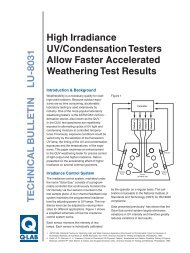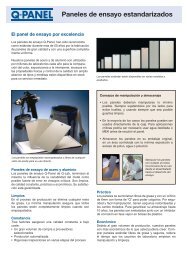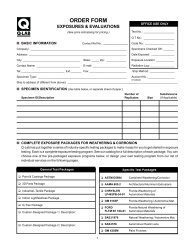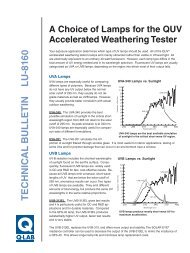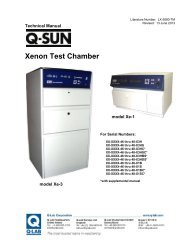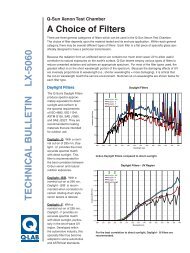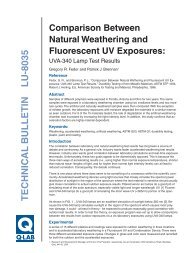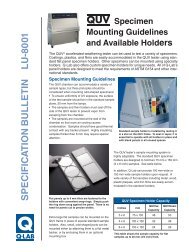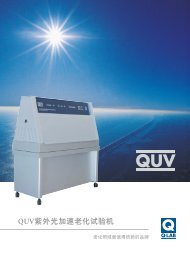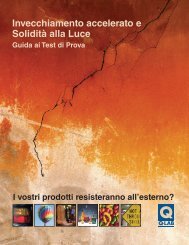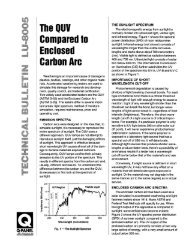Sunlight, Weathering, Light Stability - Q-Lab
Sunlight, Weathering, Light Stability - Q-Lab
Sunlight, Weathering, Light Stability - Q-Lab
You also want an ePaper? Increase the reach of your titles
YUMPU automatically turns print PDFs into web optimized ePapers that Google loves.
Conclusions and Caveats<br />
Correlation between laboratory and natural exposure<br />
test results will probably always be controversial.<br />
The user must educate himself to make a<br />
number of choices.<br />
Because there are several types of lab testers<br />
with multiple lamps and filters available, no single<br />
tester is perfect for every application. Short wave<br />
UV is usually best for testing polymer degradation,<br />
while the full spectrum approach is often most appropriate<br />
for testing for color change of pigments<br />
and dyes.<br />
<strong>Light</strong> sources that produce very short wavelength<br />
UV give fast results, but they may not always be<br />
accurate. Usually when they are wrong, they are<br />
wrong on the safe side in that the results are too<br />
severe. <strong>Light</strong> sources that eliminate wavelengths<br />
below the solar cut-off of 295 nm will give more<br />
accurate results, but the price for increased correlation<br />
is usually reduced acceleration. As Fischer<br />
has shown, test speed and accuracy are inversely<br />
related.<br />
In addition, we should point out that despite the<br />
current interest in light energy, the spectrum of a<br />
test device is only one piece of the puzzle. With<br />
any accelerated tester, there are a number of<br />
parameters that can be programmed: spectrum,<br />
moisture, humidity, temperature and test cycle.<br />
Furthermore, the parameters that one chooses<br />
are, to a certain extent, arbitrary. No single test<br />
cycle or device can reproduce all of the variables<br />
found outdoors in different climates, altitudes and<br />
latitudes. Consequently, even the most elaborate<br />
tester is really just a screening device. The real<br />
usefulness of accelerated testers is that they can<br />
give reliable, relative indications of which materials<br />
perform best under a specific set of conditions.<br />
Acknowledgements<br />
The authors are responsible for the accuracy of<br />
this paper. However we would like to recognize<br />
the assistance of:<br />
Kit Peak National Observatory<br />
Ohio Spectrographic Service<br />
3M Company<br />
BASF Corporation<br />
Americhem Corporation<br />
Reference Note<br />
This paper was originally presented at the Society<br />
of Plastics Engineers Automotive RETEC in 1987,<br />
and published as the Q-PANEL ® technical bulletin<br />
<strong>Sunlight</strong>, UV and Accelerated <strong>Weathering</strong> in 1994.<br />
The paper was revised in 2007 and rereleased as<br />
<strong>Sunlight</strong>, <strong>Weathering</strong> and <strong>Light</strong> <strong>Stability</strong> Testing.<br />
9



